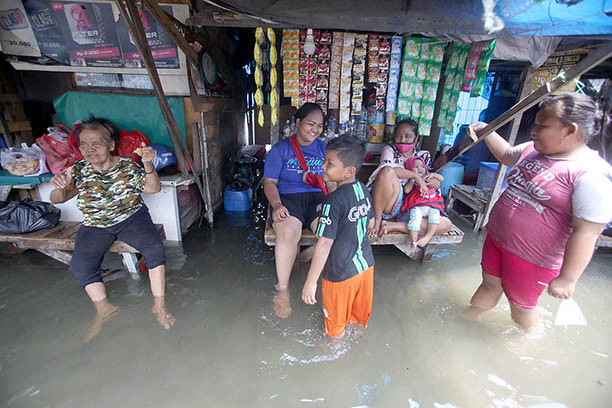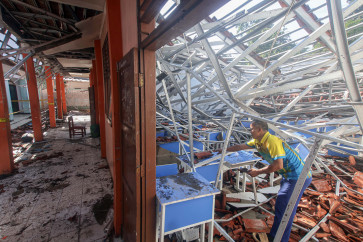Popular Reads
Top Results
Can't find what you're looking for?
View all search resultsPopular Reads
Top Results
Can't find what you're looking for?
View all search resultsReporting platform will boost disaster response: Observers
Last year, Indonesia recorded 9,384 disasters, including earthquakes, tsunamis, floods, land liquefaction and landslides, which left 684 people dead. This year, as of Sept. 3, the National Disaster Mitigation Agency (BNPB) had recorded 1,944 disasters killing 272 people.
Change text size
Gift Premium Articles
to Anyone
I
ndonesia has been experiencing frequent seismic activity as it sits on the Pacific Ring of Fire, an arc of volcanoes and fault lines encircling the Pacific Basin, making it one of the world’s most seismically active regions prone to tectonic and volcanic eruptions, earthquakes and tsunamis.
In addition, man-made disasters such as urban flooding persist in many regions.
Last year, Indonesia recorded 9,384 disasters, including earthquakes, tsunamis, floods, land liquefaction and landslides, which left 684 people dead. This year, as of Sept. 3, the National Disaster Mitigation Agency (BNPB) had recorded 1,944 disasters killing 272 people.
Despite having frequent disasters, emergency preparedness among the public is still deemed lacking, experts have said.
“People must realize that we are in disaster-prone areas, hence we should be aware of it, especially those living in areas where disasters do not happen frequently,” said civil engineering professor Abdul Hakam from Andalas University in Padang, West Sumatra.
The former head of Gadjah Mada University's (UGM) disaster studies center, Djati Mardiatno, said people's awareness level varied in each region, depending on the frequency of disasters. But even though they have adapted to live in disaster-prone areas, some places should be free from human settlements.
“There are some places that do not support a good quality of life, so it is no longer feasible to take mitigation measures there. But some people tend to go too far in adapting to the situation that they no longer see a disaster as a threat.”
In that case, people might postpone evacuating the area upon early warning, Djati said.
In February, the National Disaster Mitigation Agency (BNPB) launched nationwide petabencana.id, a crowdsourcing information platform that provides up-to-date situational information to optimize emergency responses during disasters and run by non-profit organization Yayasan Peta Bencana.
Petabencana.id was first initiated by the foundation in 2013 as a pilot project of a real-time flood map in Jakarta to help users make time-critical decisions about safety and navigation during floods.
With the launch in February, the platform has expanded to a national-scale coverage that accommodates more types of disasters, including earthquakes, forest fires and storms.
Petabencana.id director Nashin Mahtani said the real-time reporting platform had contributed to the emergency response of local disaster agencies, in combination with information from various other sources the agencies have gathered.
The information the platform collects from local residents, particularly through social media, is verified using artificial intelligence, and then it would respond to the residents to confirm the real-life situation, Nashin said.
“Only confirmed reports are published on the interactive map,” she told the Post recently. “At the same time, we work with disaster agencies. They can also verify the information with their own internal communication method.”
During heavy rain in Jakarta, Peta Bencana commonly receives up to 4,000 reports a day, she said, indicating that many people have turned to the platform for either reporting or monitoring floods.
“Especially during the COVID-19 pandemic, it is really important to have real-time information-sharing platforms [...] and [together] build emergency preparedness. When everyone plays their part, we can minimize the risk and the spread of COVID-19,” she added.
The head of BNPB's operational control center, Bambang Surya Putra, acknowledged that petabencana.id and other relevant sources had helped the agency to speed up its emergency responses. He said the agency also had a real-time reporting platform that was being used for internal purposes.
However, Bambang stressed that such a sharing platform would not necessarily help residents to make a decision to evacuate as some people were still ignorant of potential disasters. He cited the example of people living on riverbanks who only fled their home when floodwaters had reached their neck.
“Hence, [sharing information and warning] should be accompanied by efforts to improve how people react to disaster and how to immediately [and safely] evacuate,” he said. “We need a combination of technology and dissemination for behavior changing regarding disaster response.”
In order to improve awareness, Nashin said the foundation had opened free training for institutions, especially schools throughout the nation, so that they could operate and benefit from petabencana.id.
“We have been working with many different organizations and schools to spread the platform because everyone needs to be prepared. We are focusing on high-risk communities,” she said.
UGM’s Djati and Andalas' Abdul both suggested local authorities periodically disseminate or train communities regarding emergency preparedness for particular disasters that potentially or frequently occurred in their regions.










